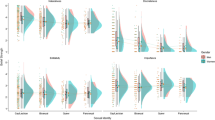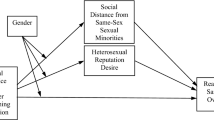Abstract
Few studies have focused on intragroup variations in sexual orientation and fewer on self-identified heterosexuals with same-sex attractions, fantasies, and/or behaviors. Self-identified heterosexual students at a large public midwestern university (N = 263) completed measures of sexuality and gender, attitudes toward lesbian, gay, and bisexual (LGB) people, religious and political beliefs, emotional well-being, and demographics. The sample included 82 individuals (31%; labeled “H+”) who endorsed same-sex attraction, fantasy, and/or behavior and 181 (69%; labeled “H”) who did not. Women were more likely to be categorized as H+ than men. H+ participants had more positive attitudes toward lesbians and gay and bisexual men and reported more support for LGB-positive public policies than did H participants. H+ participants reported less literalistic beliefs about religious scripture than did H participants. H and H+ groups did not differ significantly on measures of emotional well-being. Results were discussed in the context of recent literature arguing for a more nuanced and gender-differentiated approach toward assessing sexual orientation, as well as literature on the flexibility of sexual orientation and on heterosexual identity development.

Similar content being viewed by others
References
Anderson, R., & Fetner, T. (2008). Cohort differences in tolerance of homosexuality: Attitudinal change in Canada and the United States, 1981–2000. Public Opinion Quarterly, 72, 311–330. doi:10.1093/poq/nfn017.
Bailey, J. M., Dunne, M. P., & Martin, N. G. (2000). Genetic and environmental influences on sexual orientation and its correlates in an Australian twin sample. Journal of Personality and Social Psychology, 78, 524–536. doi:10.1037/0022-3514.78.3.524.
Baumeister, R. F. (2000). Gender differences in erotic plasticity: The female sex drive as socially flexible and responsive. Psychological Bulletin, 126, 247–374. doi:10.1037/0033-2909.126.3.347.
Brown, T. A., Chorpita, B. F., & Barlow, D. H. (1998). Structural relationships among dimensions of the DSM-IV anxiety and mood disorders and dimensions of negative affect, positive affect, and autonomic arousal. Journal of Abnormal Psychology, 107, 179–192. doi:10.1037/0021-843X.107.2.179.
Busseri, M. A., Willoughby, T., Chalmers, H., & Bogaert, A. R. (2006). Same-sex attraction and successful adolescent development. Journal of Youth and Adolescence, 35, 563–575. doi:10.1007/s10964-006-9071-4.
Busseri, M. A., Willoughby, T., Chalmers, H., & Bogaert, A. R. (2008). On the association between sexual attraction and adolescent risk behavior involvement: Examining mediation and moderation. Developmental Psychology, 44, 69–80. doi:10.1037/0012-1649.44.1.69.
Chandra, A., Mosher, W. D., Copen, C., & Sionean, C. (2011). Sexual behavior, sexual attraction, and sexual identity in the United States: Data from the 2006–2008 National Survey of Family Growth. National Health Statistics Reports, 36. Hyattsville, MD: National Center for Health Statistics. Retrieved from http://www.cdc.gov/nchs/data/nhsr/nhsr036.pdf.
Cochran, S. D., Sullivan, J. G., & Mays, V. M. (2003). Prevalence of mental disorders, psychological stress, and mental health services use among lesbian, gay, and bisexual adults in the United States. Journal of Consulting and Clinical Psychology, 71, 53–61. doi:10.1037/0022-006X.71.1.53.
Cohen, J. (1988). Statistical power analysis for the behavioral sciences. Hillsdale, NJ: Lawrence Erlbaum Associates.
Diamond, L. M. (2008). Sexual fluidity: Understanding women’s love and desire. Cambridge, MA: Harvard University Press.
DiPlacido, J. (1998). Minority stress among lesbians, gay men, and bisexuals: A consequence of heterosexism, homophobia, and stigmatization. In G. M. Herek (Ed.), Stigma and sexual orientation, understanding prejudice against lesbians, gay men, and bisexuals (Vol. 4, pp. 138–159). Thousand Oaks, CA: Sage.
Dunne, M. P., Bailey, J. M., Kirk, K. M., & Martin, N. G. (2000). The subtlety of sex-atypicality. Archives of Sexual Behavior, 29, 549–565. doi:10.1023/A:1002002420159.
Ellis, L., Robb, B., & Burke, D. (2005). Sexual orientation in United States and Canadian college students. Archives of Sexual Behavior, 34, 569–581. doi:10.1007/s10508-005-6283-8.
Eskin, M., Kaynak-Demir, H., & Demir, S. (2005). Same-sex sexual orientation, childhood sexual abuse, and suicidal behavior in university students in Turkey. Archives of Sexual Behavior, 34, 185–195. doi:10.1007/s10508-005-1796-8.
Essig, L. (2000). Heteroflexibility. Salon. Retrieved from http://archive.salon.com/mwt/feature/2000/11/15/heteroflexibility/.
Harris, J. I., Cook, S. W., & Kashubeck-West, S. (2008). Religious attitudes, internalized homophobia and identity in gay and lesbian adults. Journal of Gay and Lesbian Mental Health, 12, 205–225. doi:10.1080/19359700802111452.
Herek, G. M. (1984). Attitudes toward lesbians and gay men: A factor-analytic study. Journal of Homosexuality, 10, 39–51. doi:10.1300/J082v10n01_03.
Herek, G. M. (1988). Heterosexuals’ attitudes toward lesbians and gay men: Correlates and gender differences. Journal of Sex Research, 25, 451–477. doi:10.1080/00224498809551476.
Herek, G. M. (2000). Sexual prejudice and gender: Do heterosexuals’ attitudes about lesbians and gay men differ? Journal of Social Issues, 56, 251–266. doi:10.1111/0022-4537.00164.
Herek, G. M., & Capitanio, J. P. (1995). Black heterosexuals’ attitudes toward lesbians and gay men in the United States. Journal of Sex Research, 32, 95–105. doi:10.1080/00224499509551780.
Herek, G. M., & Capitanio, J. P. (1996). “Some of my best friends”: Intergroup contact, concealable stigma, and heterosexuals’ attitudes toward gay men and lesbians. Personality and Social Psychology Bulletin, 22, 412–424. doi:10.1177/0146167296224007.
Herek, G. M., & Glunt, E. K. (1995). Identity and community among gay and bisexual men in the AIDS era: Preliminary findings from the Sacramento Men’s Health Study. In G. M. Herek & B. Greene (Eds.), AIDS, identity, and community: The HIV epidemic and lesbians and gay men (pp. 55–84). Thousand Oaks, CA: Sage.
Kellstedt, L., & Smidt, C. (1991). Measuring fundamentalism: An analysis of different operational strategies. Journal for the Scientific Study of Religion, 30, 259–278. doi:10.2307/1386972.
Kessler, R. C., McGonagle, K. A., Zhao, S., Nelson, C. B., Hughes, M., Eshleman, S., et al. (1994). Lifetime and 12-month prevalence of DSM-III-R psychiatric disorders in the United States: Results from the National Comorbidity Survey. Archives of General Psychiatry, 51, 8–19. doi:10.1007/s10508-005-1795-9.
Kite, M. E., & Whitley, B. E. (2003). Do heterosexual men and women differ in their attitudes toward homosexuality? A conceptual and methodological analysis. In L. D. Garnets & D. C. Kimmel (Eds.), Psychological perspectives on lesbian, gay, and bisexual experiences (pp. 165–187). New York: Columbia University Press.
Klein, F. (1990). The need to view sexual orientation as a multivariable dynamic process: A theoretical perspective. In D. McWhirter, S. A. Sanders, & J. M. Reinsch (Eds.), Homosexuality/heterosexuality: Concepts of sexual orientation (pp. 277–282). New York: Oxford University Press.
Klein, F., Sepekoff, B., & Wolf, T. J. (1985). Sexual orientation: A multivariable dynamic process. In F. Klein & T. J. Wolf (Eds.), Bisexualities: Theory and research (pp. 35–49). New York: Haworth.
Laumann, E. O., Gagnon, J. H., Michael, R. T., & Michaels, S. (1994). The social organization of sexuality: Sexual practices in the United States. Chicago: University of Chicago Press.
Leary, M. R. (1983). Social anxiousness: The construct and its measurement. Journal of Personality Assessment, 47, 66–75. doi:10.1207/s15327752jpa4701_8.
Meyer, I. H. (2003). Prejudice, social stress, and mental health in lesbian, gay, and bisexual population: Conceptual issues and research evidence. Psychological Bulletin, 129, 674–697. doi:10.1037/0033-2909.129.5.674.
Meyer, I. H., & Dean, L. (1998). Internalized homophobia, intimacy, and sexual behavior among gay and bisexual men. In G. M. Herek (Ed.), Stigma and sexual orientation: Understanding prejudice against lesbians, gay men, and bisexuals (pp. 160–186). Thousand Oaks, CA: Sage.
Mohr, J. J., & Rochlen, A. B. (1999). Measuring attitudes regarding bisexuality in lesbian, gay male, and heterosexual populations. Journal of Counseling Psychology, 46, 353–369. doi:10.1037/0022-0167.46.3.353.
Morales Knight, L. F., Emge, T., & Hope, D. A. (2008). Assessing sexual orientation is more complicated than one expects: A factor analysis of the Klein Grid. Poster presented at the meeting of the Association for Behavioral and Cognitive Therapies, Orlando, FL.
Morgan, E. M., & Thompson, E. M. (2006). Young women’s sexual experiences within same-sex friendship: Discovering and defining bisexual and bi-curious identity. Journal of Bisexuality, 6(3), 9–34.
Mulvey, L. (1975). Visual pleasure and narrative cinema. Screen, 16(3), 6–18.
Murphy, H. E. (2007). Suicide risk among gay, lesbian, and bisexual college youth. Unpbulished doctoral dissertation, University of Washington.
Rosenberg, M. (1965). Society and the adolescent self-image. Princeton, NJ: Princeton University Press.
Russell, S. T. (2006). Substance use and abuse and mental health among sexual minority youth: Evidence from Add Health. In A. Omoto & H. Kurtzman (Eds.), Sexual orientation and mental health: Examining identity and development in lesbian, gay, and bisexual people (pp. 13–35). Washington, DC: American Psychological Association.
Sandfort, T. G. M., de Graaf, R., Bijl, R. V., & Schnabel, P. (2001). Same-sex sexual behavior and psychiatric disorders: Findings from the Netherlands Mental Health Survey and Incidence Study (NEMESIS). Archives of General Psychiatry, 58, 85–91. doi:10.1001/archpsyc.58.1.85.
Savin-Williams, R. C. (2006). Who’s gay? Does it matter? Current Directions in Psychological Science, 15, 40–44. doi:10.1111/j.0963-7214.2006.00403.x.
Savin-Williams, R. C. (2008). How many gays are there? It depends. In D. A. Hope (Ed.), Contemporary perspectives on lesbian, gay, and bisexual identities (pp. 5–42). New York: Springer.
Savin-Williams, R. C., & Ream, G. L. (2007). Prevalence and stability of sexual orientation components during adolescence and young childhood. Archives of Sexual Behavior, 37, 385–394. doi:10.1007/s10508-006-9088-5.
Sell, R., Wells, J., & Wypij, D. (1995). The prevalence of homosexual behavior in the United States, the United Kingdom and France: Results of national population-based samples. Archives of Sexual Behavior, 24, 235–248. doi:10.1007/BF01541598.
Thompson, E. M., & Morgan, E. M. (2008). “Mostly straight” young women: Variations in sexual behavior and identity development. Developmental Psychology, 44, 15–21. doi:10.1037/0012-1649.44.1.15.
Udry, J. R., & Chantala, K. (2002). Risk assessment of adolescents with same-sex relationships. Journal of Adolescent Health, 31, 84–92. doi:10.1016/S1054-139X(02)00374-9.
Vrangalova, Z., & Savin-Williams, R. C. (2010). Correlates of same-sex sexuality in heterosexually-identified young adults. Journal of Sex Research, 47, 92–102. doi:10.1080/00224490902954307.
Watson, D., Clark, L. A., & Tellegen, A. (1988). Development and validation of brief measures of positive and negative affect: The PANAS scales. Journal of Personality and Social Psychology, 54, 1063–1070. doi:10.1037/0022-3514.54.6.1063.
Weinrich, J. D., Snyder, P. J., Pillard, R. C., Grant, I., Jacobson, D. L., Robinson, S. R., et al. (1993). A factor analysis of the Klein Sexual Orientation Grid in two disparate samples. Archives of Sexual Behavior, 22, 157–168. doi:10.1007/BF01542364.
Wichstrøm, L., & Hegna, K. (2003). Sexual orientation and suicide attempt: A longitudinal study of the general Norwegian adolescent population. Journal of Abnormal Psychology, 112, 144–151. doi:10.1037/0021-843X.112.1.144.
Worthington, R. L., Savoy, H. B., Dillon, F. R., & Vernaglia, E. R. (2002). Heterosexual identity development: A multidimensional model of individual and social identity. The Counseling Psychologist, 30, 496–531. doi:10.1177/00100002030004002.
Acknowledgments
We are grateful to Brandé Lontine for contributing the questionnaire on political beliefs and policy positions that was used in this article. Portions of this article were presented at annual meetings of the Association of Behavioral and Cognitive Therapies, November 2007, 2008, and 2009, and at the annual meeting of the Society for the Psychological Study of Social Issues, June 2008.
Author information
Authors and Affiliations
Corresponding author
Rights and permissions
About this article
Cite this article
Morales Knight, L.F., Hope, D.A. Correlates of Same-Sex Attractions and Behaviors Among Self-Identified Heterosexual University Students. Arch Sex Behav 41, 1199–1208 (2012). https://doi.org/10.1007/s10508-012-9927-5
Received:
Revised:
Accepted:
Published:
Issue Date:
DOI: https://doi.org/10.1007/s10508-012-9927-5




